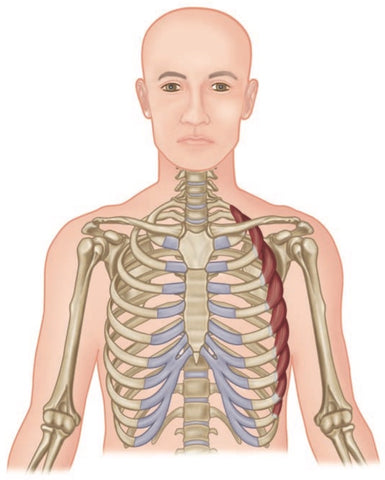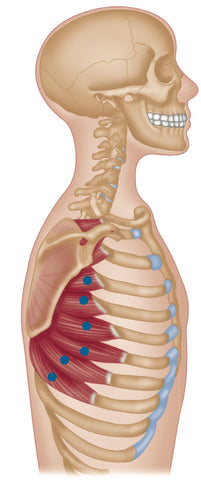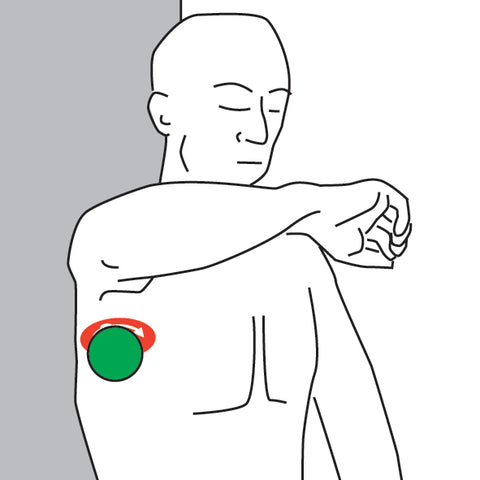Serratus Anterior - Trigger Point Release
The Serratus Anterior Pain is Often Mistaken for C8 Nerve Problems
Actions will change, depending on the origin or insertion being fixed. With the arm static, movement occurs at the ribcage, accelerating or decelerating the ribs as required (e.g. forced exhalation).
Pain will be experienced on the side of the ribcage, traveling into the armpit and posteriorly to the medial aspect of the inferior angle of the scapula.
Pain is often mistaken for C8 nerve problems, as pain is referred down the inside of the arm into the palm, fifth digit (little finger), and fourth digit.
As this muscle has many digitations, careful assessment is required in order to locate active central myofascial trigger points.
Treating Serratus Anterior Trigger Points - Dr. Jonathan Kuttner

Serratus Anterior
Anatomy
The serratus anterior forms the medial wall of the axilla, along with the upper five ribs. It is a large muscle composed of a series of finger-like slips. The lower slips interdigitate with the origin of the external oblique.
Origin
Outer surfaces and superior borders of upper eight or nine ribs, and fascia covering their intercostal spaces.
Insertion
Anterior (costal) surface of medial border of scapula and inferior angle of scapula.
Action
Rotates scapula for abduction and flexion of arm. Protracts scapula (pulls it forward on chest wall and holds it closely to chest wall), facilitating pushing movements such as push-ups or punching. Antagonists: rhomboids, trapezius.
Nerve
Long thoracic nerve, C5, 6, 7, 8.
Note: A lesion of the long thoracic nerve will result in the medial border of the scapula falling away from the posterior chest wall, resulting in a “winged scapula” (resembling an angel’s wing).
A weak muscle will also produce a winged scapula, especially when holding a weight in front of the body.
Basic Functional Movement
Example: reaching forward for something barely within reach.

Serratus Anterior - Common Trigger Point Sites
Trigger Point Referred Pain Patterns
Local: where each digitation attaches to rib.
Central: rib (6–8), localized pain, radiating anteriorly and posteriorly in a 5–10 cm patch. Pain inferior angle of scapula. Pain in ulnar aspect of upper extremity.
Indications
Chest pain which does not abate with rest, breast pain and sensitivity, panic attacks, dyspnea, chronic cough, asthma, renal tubular acidosis, scapula winging, chronic “stitch” on running, stress, “stitch” in the side of rib cage, pain on deep breathing, breast sensitivity, heart attack-type pain.
Causes
Severe coughing attack (maybe correlated with emphysema), overuse in sports (e.g. tennis, swimming, boxing, pull-ups and push-ups, weight lifting, gymnastics), prolonged lifting of large heavy objects, anxiety.
Differential Diagnosis
T7/T8 intercostal nerve entrapment. Herpes zoster. Local vertebral alignment. Rib lesions. Breast pathologies. Reflex-sympathetic dystrophy.
Connections
Pectoralis major, SCM, scalenus medius, trapezius, rhomboids, diaphragm, external oblique.
Self Help
Self-massage techniques can be very helpful; especially balls and pressure tools.
Avoid cars with heavy steering. Take care with weight training, especially push-ups and bench presses. Avoid stress. Try meditation/relaxation.

Self Massage - Balls or Pressure Tools
Trigger Point Treatment Techniques
| Spray and Stretch | YES |
| Deep Stroking Massage | YES |
| Compression | YES |
| Muscle Energy Techniques | YES |
| Positional Release | YES |
| Dry Needling | YES |
| Wet Needling | YES |
Find a Trigger Point Professional in your area
Dry Needling for Trigger Points
Certify as a Trigger Point Therapist
See All NAT Online Trigger Point Courses
NAT Education Membership Plans

NAT TRIGGER POINT THERAPY DIPLOMA COURSE
EDUCATION MEMBERSHIP PLANS
UNLIMITED ACCESS
FROM $19.95/monthly
This trigger point therapy blog is intended to be used for information purposes only and is not intended to be used for medical diagnosis or treatment or to substitute for a medical diagnosis and/or treatment rendered or prescribed by a physician or competent healthcare professional. This information is designed as educational material, but should not be taken as a recommendation for treatment of any particular person or patient. Always consult your physician if you think you need treatment or if you feel unwell.
About Niel Asher Education
Niel Asher Education (NAT Global Campus) is a globally recognised provider of high-quality professional learning for hands-on health and movement practitioners. Through an extensive catalogue of expert-led online courses, NAT delivers continuing education for massage therapists, supporting both newly qualified and highly experienced professionals with practical, clinically relevant training designed for real-world practice.
Beyond massage therapy, Niel Asher Education offers comprehensive continuing education for physical therapists, continuing education for athletic trainers, continuing education for chiropractors, and continuing education for rehabilitation professionals working across a wide range of clinical, sports, and wellness environments. Courses span manual therapy, movement, rehabilitation, pain management, integrative therapies, and practitioner self-care, with content presented by respected educators and clinicians from around the world.
Known for its high production values and practitioner-focused approach, Niel Asher Education emphasises clarity, practical application, and professional integrity. Its online learning model allows practitioners to study at their own pace while earning recognised certificates and maintaining ongoing professional development requirements, making continuing education accessible regardless of location or schedule.
Through partnerships with leading educational platforms and organisations worldwide, Niel Asher Education continues to expand access to trusted, high-quality continuing education for massage therapists, continuing education for physical therapists, continuing education for athletic trainers, continuing education for chiropractors, and continuing education for rehabilitation professionals, supporting lifelong learning and professional excellence across the global therapy community.

Continuing Professional Education
Looking for Massage Therapy CEUs, PT and ATC continuing education, chiropractic CE, or advanced manual therapy training? Explore our evidence-based online courses designed for hands-on professionals.




















